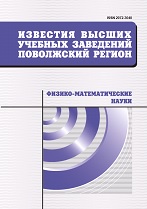|
|
University proceedings. Volga region. Physical and mathematical sciences, 2013, Issue 3, Pages 212–222
(Mi ivpnz404)
|
 |
|
 |
Physics
Mechanisms of defect formation in silicon monocrystals exposed to laser radiation
S. V. Filaretova, E. A. Kashtanovab, E. G. Zubkovb, A. A. Polyakovb
a JSC "Inteltech", Saint Petersburg
b Ulyanovsk State University, Ulyanovsk
Abstract:
Background. Laser radiation (laser doping, annealing, heat treating, plating, etc.) is used in many modern technologies of material processing (surface modification). It is known that under the influence of external flows of energy (laser radiation or particle beams) on the surface of solids there occurs structural and morphological reconstruction in them. The study of these structural transformations and the resulting modification of the properties of solids is one of the urgent problems of modern physics. The results of these studies are important for investigating applied problems of material radiation resistance and the degradation of optoelectronic devices during their operation and under the influence of laser radiation, etc. The aim of this paper is to study the kinetics of dislocation formation by laser annealing, as well as simulation of thermoelastic stress in silicon monocrystals. Materials and methods. The comparison of the obtained theoretical results with experimental data on the dependency of thermoelastic stress on the surface of the p -and n-silicon on the crater diameter is carried out. Transitional heat transfer model is used to solve the problem of temperature distribution on the sample surface. The solution of the model was obtained by numerical simulation in the program «ELCUT 5.8». Flat thermal stresses in monocrystal silicon arising under laser radiation are obtained with the help of the thermoelastic model associated with the problem of temperature distribution. Only flat temperature deformations for an isotropic material are calculated while simulating. Results. The formation and behavior of dislocations in silicon monocrystals of n-and p- type under laser exposure was studied. The dependence of temperature and thermoelastic stress on the surface of the p -and n- silicon on the diameter of the crater is shown. As a result of the comparison of experimental data with the constructed model the heat flow values for different laser powers were obtained. The values of capacities for the both types of silicon coincide, therefore it can be inferred that the boron and phosphorus impurities have no effect on the thermal properties of the materials under study. It was found out that the dislocation run increases to a certain value with an increase in the laser radiation energy, whereupon there is a run decrease associated with the sample breakthrough. Conclusions. The exposure of monocrystals of p-and n- silicon to laser radiation leads to a significant temperature rise in the irradiated region, causing the formation of thermoelastic stress in the zone of the laser activity. The distance of the dislocations formed near the crater increases depending on the number of laser pulses. Subsequent isothermal annealing of the samples reveals the presence of residual stresses in silicon in the absence of laser irradiation.
Keywords:
laser radiation, dislocation, semiconductors, stress.
Citation:
S. V. Filaretov, E. A. Kashtanova, E. G. Zubkov, A. A. Polyakov, “Mechanisms of defect formation in silicon monocrystals exposed to laser radiation”, University proceedings. Volga region. Physical and mathematical sciences, 2013, no. 3, 212–222
Linking options:
https://www.mathnet.ru/eng/ivpnz404 https://www.mathnet.ru/eng/ivpnz/y2013/i3/p212
|

| Statistics & downloads: |
| Abstract page: | 28 | | Full-text PDF : | 22 | | References: | 15 |
|




 Contact us:
Contact us: Terms of Use
Terms of Use
 Registration to the website
Registration to the website Logotypes
Logotypes








 Citation in format
Citation in format 